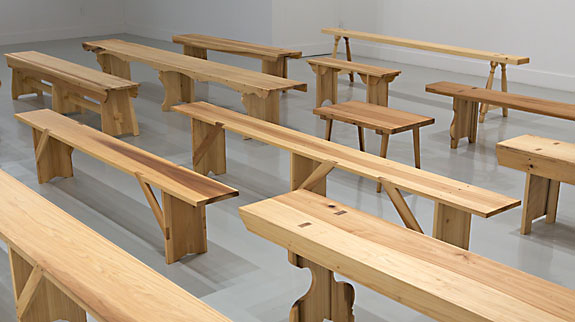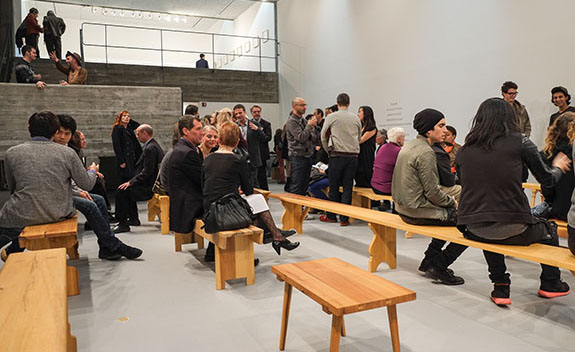 |
.jpg) |
When I visited the gallery was empty. That facilitated one aspect of what Cape is aiming for: an environment for solitary contemplation. The other aspect, the activation of social space, was achieved a few days later at the show’s opening, where, as photos reveal, visitors were intensely engaged with the art and with each other. Cape sees his work as social sculpture, and rightly so. Give people an interesting places to perch and they'll do so. The loftier, less easily grasped part of his project is how design reflects values and encourages community and equality through the shared experience — of praying, eating and meeting. That would necessarily exclude most of us.
 |
Thus, the exhibit’s appeal rests most tangibly with the objects themselves: with their exquisite joinery, simplicity, subtle variations, and, their relationship to Minimalism — Donald Judd’s furniture and the Rothko Chapel being two examples that spring immediately to mind. After that, it’s the quirks that command attention. One bench, identified as “Pennsylvania German,” is a just a skinny plank, not even as wide as a sawhorse, and too tall to sit on without dangling your legs. Another, designed by Shakers of Hancock, Massachusetts, more closely resembles a small table than a bench. It seats only one person, a child judging from its height. Yes, I know: people were shorter in the past and, for all I know, they may have had meatier rumps; but the message embedded in all this elegant austerity is that godliness and comfort don’t mix. Neither, apparently, does ornamentation, save one notable departure: The legs of one bench, whose origins I don’t recall, evoke the female form, a view that in another era might have been censored with pantalets, lest they inflame untoward desires. Of this piece it’s safe to say: it probably didn’t come from one of the ascetic groups visited by Francis.
I have no doubt that, while researching the design practices and spiritual beliefs of such sects, Francis was able to penetrate their thinking to a degree that revealed to him, the precise relationship between form, function and philosophy. For those of us just looking and sitting, it’s too big a stretch. That said, it’s easy to appreciate the designers’ – and Francis’ — abundant craft, as well as the sharp contrast between the rampant materialism of our own age and the economy of America’s earliest utopians.